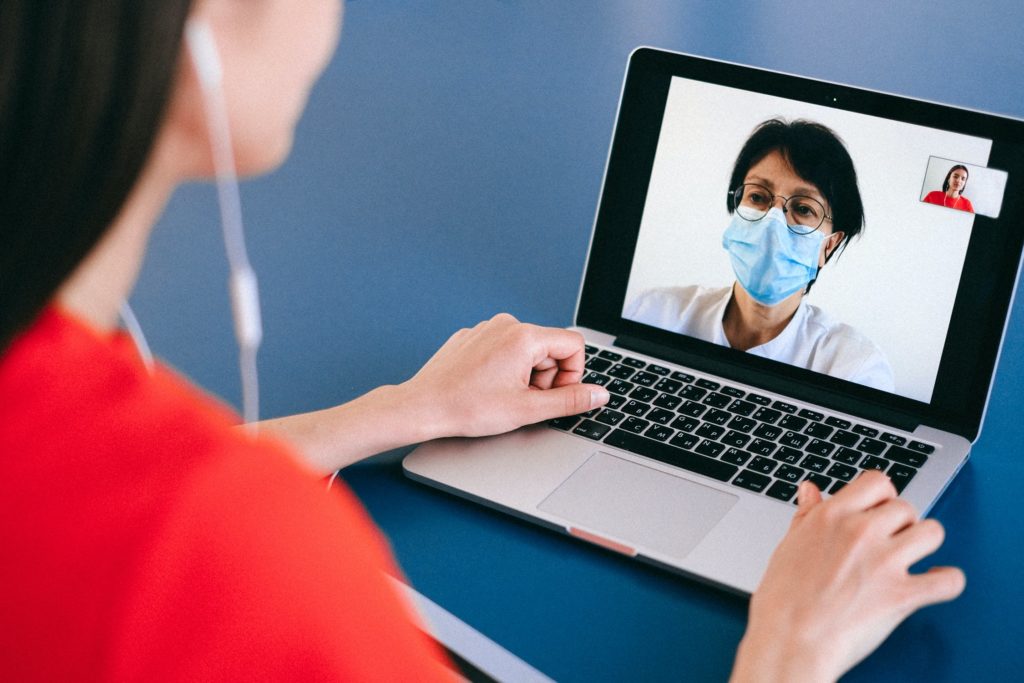
By: Erin Donnelly
Telemedicine, or telehealth, is the term that describes the use of electronic information and telecommunication technologies to provide long-distance health care to patients.[1] Telemedicine may occur over telephone calls or text messaging, but most commonly occurs with videoconferencing software.[2] Telemedicine benefits include medical accessibility (especially to patients residing in rural areas), cost-effectiveness, and an increase in patient engagement with health care providers.[3]
The aforementioned benefits of telemedicine have been highlighted amidst the COVID-19 public health crisis. In light of the pandemic, and the fact that travel restrictions made it difficult or impossible for patients to travel to their health care providers’ offices, the U.S. Department of Health and Human Services (HHS) has taken several steps in issuing waivers and guidances that made it easier for health care providers to provide care to their patients with the use of telemedicine.[4]
In March 2020, The Office of Civil Rights (OCR), of HHS, announced that it would use its enforcement discretion for the duration of the pandemic to allow health care providers to provide telehealth services to patients using remote communication technologies, even if the technology does not fully comply with the Health Information Portability and Accountability Act (HIPAA), as it normally would need to.[5] OCR announced that it would waive potential penalties for HIPAA violations against health care providers that use widely available communication applications, such as FaceTime or Skype (not HIPAA-compliant applications) when used in good faith for telemedicine purposes – regardless of whether the service is directly related to COVID-19.[6] Because of this (non)action taken by OCR, patients have been able to virtually “meet” with their health care providers from the safety of their own homes without needing to install special HIPAA-compliant software.
Additionally, the Centers for Medicare and Medicaid Services (CMS), of HHS, took steps to facilitate the use of telemedicine during the pandemic, including expanding the list of covered telehealth services that are reimbursable by Medicaid.[7] The list was expanded to include home visits and therapy services, among other things.[8] This expansion means that health care providers can provide such services to their Medicaid-covered patients through telemedicine, which was not the reality prior to the reimbursement list expansion.
The aforementioned steps taken by HHS unquestionably led to the significant expansion of the use of telemedicine over the past several months. There are clear benefits to telemedicine’s widespread use beyond the end of the COVID-19 public health crisis.[9] Additionally, the market has responded to telemedicine’s recent uptake – various service providers have recently entered the market, which is expected to reach $185.6 billion by 2026.[10] Therefore, there is a question of whether the changes made by HHS, which helped to expand the industry, may be here to stay.
For the adjustments to stay beyond the public health crisis, Congress will likely need to formally act. The OCR waiver, related to HIPAA, is unlikely to become permanent. As mentioned, telemedicine service providers have created HIPAA-compliant products that will likely protect patients’ protected health information much more effectively than Skype or FaceTime.[11] Therefore, it is unlikely that Congress would move to allow the continuance of such applications, which offer lesser privacy, far beyond the pandemic. However, the expanded list of covered telehealth services that are reimbursable by Medicaid is more likely to stay. If for some visits, patients are able to receive the same level of care through telemedicine without needing to travel into their health care provider’s office, they should be able to do so and receive the same reimbursement that they would receive had they traveled into the physical office.
In the months and years to come, following the eventual end of the COVID-19 pandemic, it will be interesting to see whether the steps taken by HHS to expand the use of telemedicine will be here to stay. Regardless, it is clear that the industry of telemedicine will continue to flourish in the United States.
[1] Telehealth, Dep’t of Health & Human Servs., https://www.hhs.gov/hipaa/for-professionals/faq/telehealth/index.html (last visited Oct. 1, 2020).
[2] Id.
[3] What is Telemedicine?, VSee., https://vsee.com/what-is-telemedicine/#:~:text=Telemedicine%20refers%20to%20the%20practice,HIPAA%20compliant%20video%2Dconferencing%20tools. (last visited Oct. 1, 2020).
[4] Telehealth: Delivering Care Safely During COVID-19, Dep’t of Health & Human Servs. (July 15, 2020), https://www.hhs.gov/coronavirus/telehealth/index.html.
[5] OCR Announces Notification of Enforcement Discretion for Telehealth Remote Communications During the COVID-19 Nationwide Public Health Emergency, Dep’t of Health & Human Servs. (Mar. 17, 2020), https://www.hhs.gov/about/news/2020/03/17/ocr-announces-notification-of-enforcement-discretion-for-telehealth-remote-communications-during-the-covid-19.html; Notification of Enforcement Discretion for Telehealth Remote Communications During the COVID-19 Nationwide Public Health Emergency, Dep’t of Health & Human Servs. (Mar. 30, 2020), https://www.hhs.gov/hipaa/for-professionals/special-topics/emergency-preparedness/notification-enforcement-discretion-telehealth/index.html; OCR Issues Guidance on Telehealth Remote Communications Following Its Notification of Enforcement Discretion, Dep’t of Health & Human Servs. (Mar. 20, 2020), https://www.hhs.gov/about/news/2020/03/20/ocr-issues-guidance-on-telehealth-remote-communications-following-its-notification-of-enforcement-discretion.html.
[6] OCR Announces Notification, supra note 5.
[7] Telehealth: Delivering Care Safely, supra note 4.
[8] Id.; List of Telehealth Services, Ctrs. for Medicare & Medicaid Servs. (Apr. 30, 2020), https://www.cms.gov/Medicare/Medicare-General-Information/Telehealth/Telehealth-Codes.
[9] What is Telemedicine?, supra note 3.
[10] Andrei Zimiles, Four New Statistics That Prove That Telemedicine Isn’t Just a Pandemic Fad, Med. Econ. (July 8, 2020), https://www.medicaleconomics.com/view/four-new-statistics-that-prove-that-telemedicine-isn-t-just-a-pandemic-fad.
[11] Id.

